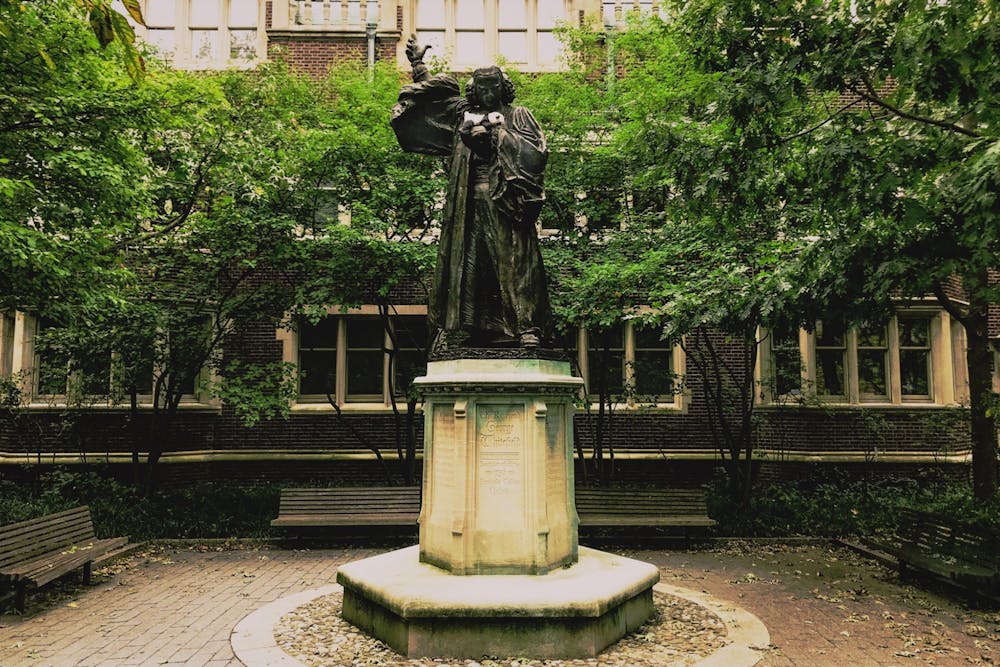
The statue of George Whitefield is currently located in the Quad.
Credit: Sunny JangAmid a national reckoning over statues that symbolize white supremacy, Penn announced its plan on Thursday morning to take down the century-old statue of George Whitefield from the Quad.
Penn President Amy Gutmann, Provost Wendell Pritchett, and Executive Vice President Craig Carnaroli wrote in the University-wide email that, after considering Whitefield’s support for and advancement of slavery in the American colonies, they have decided to take down the statue that stands in front of the Morris and Bodine sections of Ware College House.
“Honoring him with a statue on our campus is inconsistent with our University’s core values, which guide us in becoming an ever more welcoming community that celebrates inclusion and diversity,” the email read.
Although the email vowed the statue would be removed from campus, it contained no mention of when it would be removed or whether it would be replaced with another figure.
The bronze statue of Whitefield was created by R. Tait Mckenzie in 1919. Whitefield, a prominent evangelical preacher in the mid-18th century who successfully campaigned for slavery’s legislation in the Georgia colony — where the practice had been previously outlawed — owned 50 enslaved persons himself.
Penn's announcement to remove the Whitefield statue comes shortly after other Ivy League institutions have made efforts to reconcile their ties with slavery and racism. Last Saturday, Princeton University announced that it will remove the name of U.S. President Woodrow Wilson from its School of Public and International Affairs and a residential college due to his record of supporting racist practices and segregation as president.
Whitefield’s connection to the University comes from his church meeting house located on 4th and Arch streets in Philadelphia, the email read, which Penn founder Benjamin Franklin purchased for the Academy of Philadelphia that eventually became the University of Pennsylvania. The email made no mention the lifelong friendship between Whitefield and Franklin, or Whitefield’s ownership of enslaved persons.
Since the announcement, the University has removed a 2013 Penn Today article called ‘For the Record: George Whitefield’ that described Franklin’s relationship with Whitefield, but failed to mention any of the preacher’s ties to slavery. The article was still accessible earlier this week.
In addition to the removal of the Whitefield statue, Penn announced the formation of a Campus Iconography Group which will research and advise the University about memorializations on Penn's campus. The group will be chaired by Senior Vice President for Institutional Affairs and Chief Diversity Officer Joann Mitchell and Dean of the Weitzman School of Design Fritz Steiner. Members of the group will include Penn administrators and faculty, including 2000 College graduate and University Chaplain Chaz Howard, who was recently named the University's first Vice President for Social Equity and Community.
Penn’s plan to remove the Whitefield statue is the latest effort in a movement in Philadelphia, as well as across the United States, to remove confederate monuments and symbols of white supremacy.
On June 3, the city removed the statue of former Philadelphia Mayor and Police Commissioner Frank Rizzo from City Hall, who many protesters believe stood as a symbol of discrimination and police brutality. City officials also announced that they intend to remove the statue of Christopher Columbus in Marconi Plaza, after repeated violence at its location, The Philadelphia Inquirer reported.
Police Free Penn, a newly formed group, recently called on the school to remove all existing campus memorialization and Penn Museum inventory that portray people who were involved with or endorsed slavery and white supremacy.
The University's email expressed gratitude for the work done by the Penn & Slavery Project, an archival research project that examines Penn’s history in relation to the institution of slavery. The email also recognized that many of its trustees, including Benjamin Franklin, owned enslaved persons.
The Penn & Slavery Project revealed that of the 39 Residential Houses in the Quad, 10 are named after slave owners who helped the University in its early years. The University made no mention of this in the email, or of any intention to rename these buildings.
The Daily Pennsylvanian is an independent, student-run newspaper. Please consider making a donation to support the coverage that shapes the University. Your generosity ensures a future of strong journalism at Penn.
Donate







